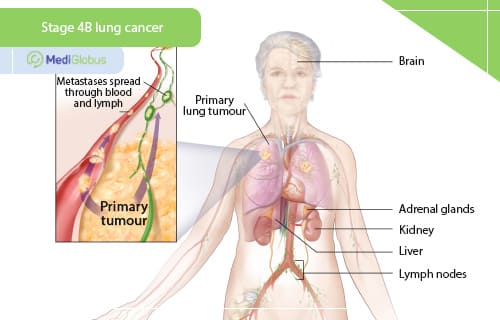In 40% of patients with non-small cell lung cancer and 66% of patients with small cell lung cancer, the disease is first detected in the fourth stage. This diagnosis comes as a shock to the patients themselves and their loved ones. Many have no idea how to proceed and may even refuse treatment. But we want to prove to you that stage 4 lung cancer is no reason to give up, and even with such an unfavourable diagnosis, medicine has much to offer to improve the well-being of the patients and their life expectancy.
Listen to the article:
Symptoms of end-stage lung cancer

The symptoms of lung cancer can vary from patient to patient. One of the most important factors is the substage of the disease: 4A or 4B. The classification is carried out according to the international TNM system. It is used by most clinics today to make a proper treatment plan based on the extent of the disease.
Stage 4A lung cancer is diagnosed if:
Cancer has spread to both lungs;
Cancer has spread to the pleura or pericardium;
Fluid analysis of the pleural cavity showed the presence of cancer cells;
A single area of distant metastasis has been found.
The symptoms of stage 4A lung cancer are:
Persistent cough with or without blood;
Shortness of breath;
Chest pain;
Fatigue;
Lowering of appetite and weight loss;
Mood swings.
Stage 4B is considered more advanced than stage 4A. It is diagnosed if the patient has several metastatic lesions in different organs. The symptoms will depend on where cancer has spread. Lung cancer most often metastasises to the lymph nodes, bones, liver, brain and adrenal glands. Consequently, in addition to the symptoms typical of stage 4A, patients may experience:
Bone pain;
Brittle bones, fractures;
Headaches;
Vision problems;
Seizures;
Nausea;
Abdominal bloating;
Jaundice.

Diagnosing lung cancer abroad
When diagnosing patients with cancer abroad, genetic testing of tumour cells is carried out, which allows for the selection of the most effective drugs of the latest generation. To make an appointment for diagnosis in a foreign clinic, please leave an application on our website by clicking the button below and filling in the form
Can stage 4 lung cancer be cured?

For the treatment of stage 4 lung cancer, doctors take a holistic approach: combining several methods to control the disease as effectively as possible. Palliative care is also relevant at this stage. This is the type of treatment that does not aim to cure the disease but to eliminate symptoms and improve the patient’s quality of life.
Stage 4 lung cancer is considered to be a disease that cannot be “completely cured” due to its poor prognosis. However, modern medicine has achieved a lot in improving the quality and length of life of terminal patients. Many live on for years instead of the promised few months.
Doctors take many factors into account when making a treatment plan for stage 4 lung cancer. The most important of them are:
Type of cancer (adenocarcinoma, large cell carcinoma, squamous cell carcinoma, etc.);
Presence and location of metastases;
Co-morbidities.
If possible, the doctor will try to remove the tumour by surgery. However, depending on the extent of the organ damage, it may not always be possible or recommended.
For stage 4 non-small cell lung cancer, doctors combine individually tailored chemotherapy, targeted therapy and immunotherapy to control the disease. Genetic testing is always carried out before treatment begins, which allows the selection of suitable drugs. The aggressiveness of the course depends on the patient’s well-being. Chemotherapy is the mainstay of treatment for stage 4 small cell lung cancer. It is usually supplemented by radiation therapy to the chest and brain (to prevent metastases).
Surgery and radiotherapy are also actively used to treat cancer metastases, especially in the brain and liver.
A wide range of methods is used to control the symptoms of the disease, which are selected according to the location of the lesion and the patient’s general condition. These include external beam therapy, brachytherapy, laser therapy, cryotherapy, tracheal stenting and photodynamic therapy.
The main methods used to treat stage 4 lung cancer:
Chemotherapy | Chemotherapy, usually given intravenously, is used to reduce or control the size of malignant tumours. Patients are usually given 4-6 cycles of combination drugs at intervals.
Older patients often have poor tolerance to the side effects of chemotherapy, so this method of treatment may be contraindicated for them. |
Targeted therapy | Target therapy, unlike chemotherapy, targets cancer cells. This means that there are fewer side effects. This group of drugs requires testing for specific cell mutations: EGFR, KRAS, ALK, ROS1, BRAF, RET, MET, HER2, and NTRK. For each of these, there is a set of drugs that can be used in the treatment of lung tumours. |
Immunotherapy | Since 2015, the FDA has approved 11 immunotherapy drugs for the treatment of late-stage lung cancer, and several more are currently in trials. This method is usually used in combination with chemotherapy, but it can also be prescribed as a standalone treatment. Immunotherapy ‘helps’ a person’s immune system to recognise cancer cells and fight them on its own. This can lead to the tumours stopping growing or even shrinking. |
Radiation therapy | High-dose stereotactic radiotherapy (SIRT) is most commonly used to treat stage 4 lung cancer. It is prescribed to control brain metastases, and treat pain, lung bleeding and breathing difficulties. |
Brachytherapy | Brachytherapy is a method related to radiation therapy. Its main difference is that the radiation source is placed inside the body directly next to the tumour. This allows higher doses of radiation to be delivered. Brachytherapy is one of the most effective methods of treating respiratory disorders. |
Laser therapy | Laser treatment for lung cancer is carried out using a bronchoscope – a special machine that allows the doctor to access the cancerous lesion through the mouth. The procedure takes about half an hour under anaesthetic. |
Cryotherapy | Cryotherapy is used as an alternative to surgery for patients for whom open surgery is contraindicated, usually due to their advanced age or frail condition. The method uses ultra-low temperatures to destroy malignant cells. Research shows that cryotherapy also boosts the body’s immune response to cancer. |
Tracheal stenting | Stenting is an operation that is performed to maintain airway patency. |
Photodynamic therapy | Photodynamic therapy has been approved for the treatment of lung cancer since 1998. The patient gets injected with a special antitumor agent, which is then activated by the laser. |
In addition to maintaining physical health, terminal cancer patients are in great need of psychological support. Contacting a psychologist who specialises in working with cancer patients or a support group can be very helpful.
Pain management for stage 4 lung cancer
Pain is one of the most common complaints of patients in the terminal stages of cancer. Leading clinics abroad place great emphasis on maintaining the quality of life of cancer patients, and therefore on pain control. Pain can be caused by several different causes, including tumour pressure on neighbouring tissues, regional or distant spread of cancer, or side effects of anti-cancer treatment.
Painkillers are usually prescribed to control chronic pain. The doctor will choose the medicine individually based on the severity of the symptom and other factors.
When nerve endings are affected, injections can be made that stop the transmission of nerve signals for about three weeks.
A surgical approach such as an anterolateral cordotomy (cutting of the spinal nerves) or rhizotomy (destruction of the dorsal sensory roots) can also be used. Side effects of such interventions include partial loss of tactile and temperature sensation.

Radiotherapy also remains an effective method of controlling pain in stage 4 lung cancer. It is used in 40-50% of patients with this diagnosis, and 90% of cases – for palliative purposes.
The prognosis for stage 4 lung cancer
End-stage lung cancer has the worst prognosis for treatment. Statistics show that about 15-19% of patients live more than a year. However, these figures do not tell the whole story. The stage of the disease is not the only thing that affects the prognosis for survival. When other factors are taken into account, patients’ chances of survival can be much higher. With the right approach to treatment, many can live several more years with a good quality of life.
What affects the prognosis of treatment for stage 4 lung cancer:
Type of cancer
The prognosis for the treatment of various cancers differs. The five-year survival rate for lung adenocarcinoma is 20,6%, for squamous cell lung cancer it’s 17,6%, and for large cell lung cancer, it’s 13,2%. One of the best prognoses is for bronchioloalveolar adenocarcinoma.
General health condition
The presence of comorbidities, especially heart failure, cerebrovascular disease and diabetes, worsens the prognosis for treatment. In contrast, people with better health can tolerate more aggressive treatment protocols.
Presence of certain genetic mutations
If a patient is found to have genetic mutations, such as EGFR, ALK, and ROS1, they will be able to take targeted therapy, which will significantly increase life expectancy. One study of the effectiveness of Xalkori showed that among patients with terminal lung cancer who took it, the five-year survival rate rose from 2% to over 50%.
Smoking
Giving up smoking is one of the most effective ways of improving the prognosis of patients with lung cancer. Studies have shown that patients who give up the habit before starting chemotherapy live at least six months longer.
The body’s response to treatment
The effectiveness of chemotherapy, radiation therapy, targeted therapy and other methods differs from patient to patient and cannot be predicted in advance.
It is important to remember that if one drug has not had the expected effect, the doctor may choose another.
Ability to carry out daily activities
The ECOG PS scale is used to assess the capacity of terminally ill cancer patients in Western hospitals. About half of patients have a score of 0-2 at the time of diagnosis, which gives them a more favourable prognosis. The five-year survival rate of patients with the lowest score is 45.9%.
Patient’s age
Patients under 50 years of age have three times higher treatment prognosis than people over 65.
Make an appointment for lung cancer treatment abroad
Time is of the essence in cancer treatment. To quickly get an appointment with an experienced oncologist, leave your application on our website by clicking on the button below. Our coordinating doctors will call you back within a few hours for a free consultation and they’ll help organise your treatment abroad.
How can I help a loved one with stage 4 lung cancer?

Terminal lung cancer affects a person psychologically and emotionally. They must have people close to them who can give the help and support they need – both physically and emotionally.
People approaching the end of life may experience fear of death. It can prevent a person from experiencing happiness in life and even stand in the way of treatment. It is important to let them know that it is normal to have such feelings and that there are people who can help deal with them. Clinical psychologists working with cancer patients know how to find the right approach and help the patient to accept reality as it is.
People with advanced cancer may also often experience loneliness and the feeling that no one can understand what they are going through. In such cases, support groups, where you can talk to other people in the same situation, can be helpful. Talking to doctors or medical staff can also be helpful.
The American Cancer Society notes that regret over the past is another common experience of terminal cancer patients. It can be difficult to distance oneself from such thoughts. To better prioritise and focus on the present, one can, for example, keep a diary, write letters or make notes for loved ones. No matter how one feels about late-stage cancer, talking about these feelings with a loved one can be helpful and comforting.
A stage 4 cancer survivor’s story
AJ Patel does not fit the picture of the stereotypical lung cancer patient – he is young and healthy, doesn’t smoke, has an active lifestyle, goes running and plays football. When he started suffering from frequent coughing in 2011, no one could have guessed that the man would be diagnosed with cancer two years later. The doctor’s CT scan showed multiple foci of the disease in both lungs with brain metastases – stage four disease.
Based on the initial diagnosis, doctors gave him no more than six months to live. To save AJ’s life, the oncologist prescribed an immediate course of aggressive chemotherapy.
The next stage of treatment was an operation to remove the brain tumours – two large and four small ones. The procedure went even more successfully than it was expected. In addition to removing the tumours, the doctors carried out a biomarker test – a new method in oncology at the time. It turned out that AJ had two genetic mutations that made him a suitable candidate for targeted therapy.

The man started treatment immediately. And it wasn’t long before the targeted therapy began to show results. The fact that nine years have passed and that AJ is still alive and doing well is an indication of how effective it has been.
Where should stage 4 lung cancer be treated?
Resume
Stage 4 lung cancer is the last and terminal stage of the disease. At this stage, the disease usually affects both halves of the organ and forms metastases to lymph nodes, the brain, bones, liver or adrenal glands. The fourth stage has the least favourable treatment prognosis.
Although the average survival rate of patients with stage 4 lung cancer is low, it is possible to extend it considerably if favourable factors are present. A healthy lifestyle, a high level of functionality, quitting smoking, young age, and the presence of specific genetic mutations in the tumour, combined with modern medicine, allow patients to live for many years rather than just a few months.
Methods used in stage 4 lung cancer include surgery, chemotherapy, radiation therapy, brachytherapy, immunotherapy, targeted therapy, cryotherapy, photodynamic therapy and laser therapy. Palliative care, including drug and surgical treatment of pain, plays a major role.
For the most advanced lung cancer treatment, patients can go to Liv Vadistanbul, Koç, Bona Dea, Teknon, Ichilov, Uniklinik Cologne and other clinics.
There is always hope for the patients. Contact the international MediGlobus platform and we will help you find the most suitable lung cancer clinic and organise your trip.
Sources:
- 1. National Cancer Institute: Lung and Bronchus Cancer Statistics
- 2. Journal of Thoracic Disease: Cryosurgery for lung cancer
- 3. Clinical Epidemiology: Survival by histologic subtype in stage IV nonsmall cell lung cancer based on data from the Surveillance, Epidemiology and End Results Program





